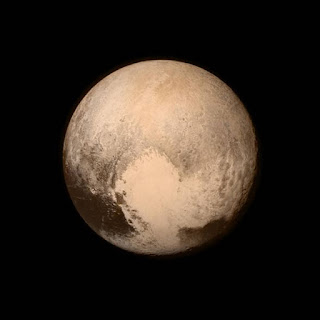
Pictured to the left is Pluto's largest moon Charon. To me it looks similar to our moon without nearly as many craters. Note the large gashes in the left edge. It is estimated that this is a canyon 4 to 6 miles deep.
Here is a picture of the massive mountains discovered on Pluto. They are believed at this time to be made of water ice.
The above pictures and more may be found at
https://www.nasa.gov/mission_pages/newhorizons/main/index.html
I was able to go outside on one outstanding evening this week, where the Milky way was clearly visible stretching across the sky overhead. Below are a few images taken on the evening of July 13 and the morning of the July 14, 2015.
This is the gorgeous Ring Nebula in the constellation Lyra, another planetary nebula, created by an exploding old star. You can see the remnant star in the middle of the ring. Through an eyepiece it has the appearance of a small smoke ring.
Here is the amazing Globular Cluster M13 in the constellation Hercules, one of the best globular's to view through an eyepiece on a dark night.
Not far from M13, is an often overlooked globular M92. Because it is not quite as bright as M13, it doesn't get observed as often at star parties, but is nearly as impressive to look at as M13. M92 resides in the constellation Hercules.
Here is an impressive open cluster named NGC 6819 located in Cygnus. There are many of these congregations of stars in the Milky Way. Many of them eventually drift apart.
This image shows the remnant of material blown off of an old star that blew up. It is called the Crescent Nebula and is located in Cygnus.
Finally this is a good example of a Spiral Galaxy. NGC 6946 is in the constellation of Cygnus and is similar to our own Milky way. Our Milky Way would look similar to this if it were viewed from a position far above it. This galaxy is estimated to be only about 1/3 the size of our Milky way.Note the spiral arms. It is about 40,000 light years across. That's how long it would take a beam of light to cross from one end to the other.








No comments:
Post a Comment